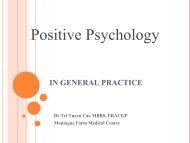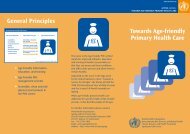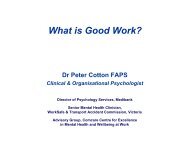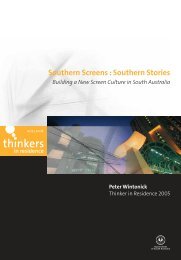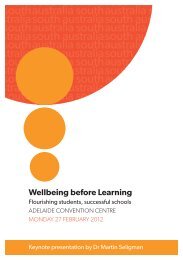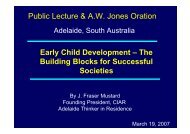Age-friendly Primary Health Care Centres Toolkit - World Health ...
Age-friendly Primary Health Care Centres Toolkit - World Health ...
Age-friendly Primary Health Care Centres Toolkit - World Health ...
- No tags were found...
Create successful ePaper yourself
Turn your PDF publications into a flip-book with our unique Google optimized e-Paper software.
AGE-FRIENDLY PRIMARY HEALTH CARE CENTRES TOOLKITII.4.2 Clinical assessment and key management approaches for the four geriatricgiantsThe organized clinical approach is an efficient way to identify, assess and managepatient care. The clinical approach as illustrated in the flowchart on the back on page42 is a stepwise flow from the 10-minute comprehensive screening throughidentification of health problems; assessment; management and follow-up.Patients who come to the PHC centre for health care will be screened by a trainedcommunity health aid in the waiting room (Step 1).If the screening is positive for any of the four geriatric giants, steps 2,3 and 4 asspecified below will be followed.If a nutritional problem is identified, the patient should be referred to the doctor (Seesection II.3).If a hearing or vision problem is identified, the patient should be referred to the doctorfor an appropriate action.The organized clinical process consists of the following four steps:Step 1: 10-minute comprehensive screening (Tool 1) Should be done by a member of the PHC centre while the patient is waiting to see thedoctor and included in the medical record. Try to provide privacy for the patient as much as possible.Step 2: Geriatric giants assessment (Tool 2 to 7) Assessment by doctors using questionnaire and physical examination. Where there are multiple conditions, the doctor needs to prioritize assessment anddecide which condition to work up in the first visit and schedule subsequent visits forother conditions. The following order is suggested:1. Memory loss2. Depression3. Urinary Incontinence4. Falls/immobilityStep 3: Diagnosis, treatment and education Establish diagnosis. Plan pharmacological and non pharmacological management strategies. Counsel patients and family/caregivers on appropriate targets for reducing risk,including education. This can be done by nurse or a community health worker. Refer to appropriate services when needed.Step 4: Follow-up Assess response and effectiveness of treatment. Change clinical management as necessary. If needed, discuss referral for specialty evaluation and management.41





